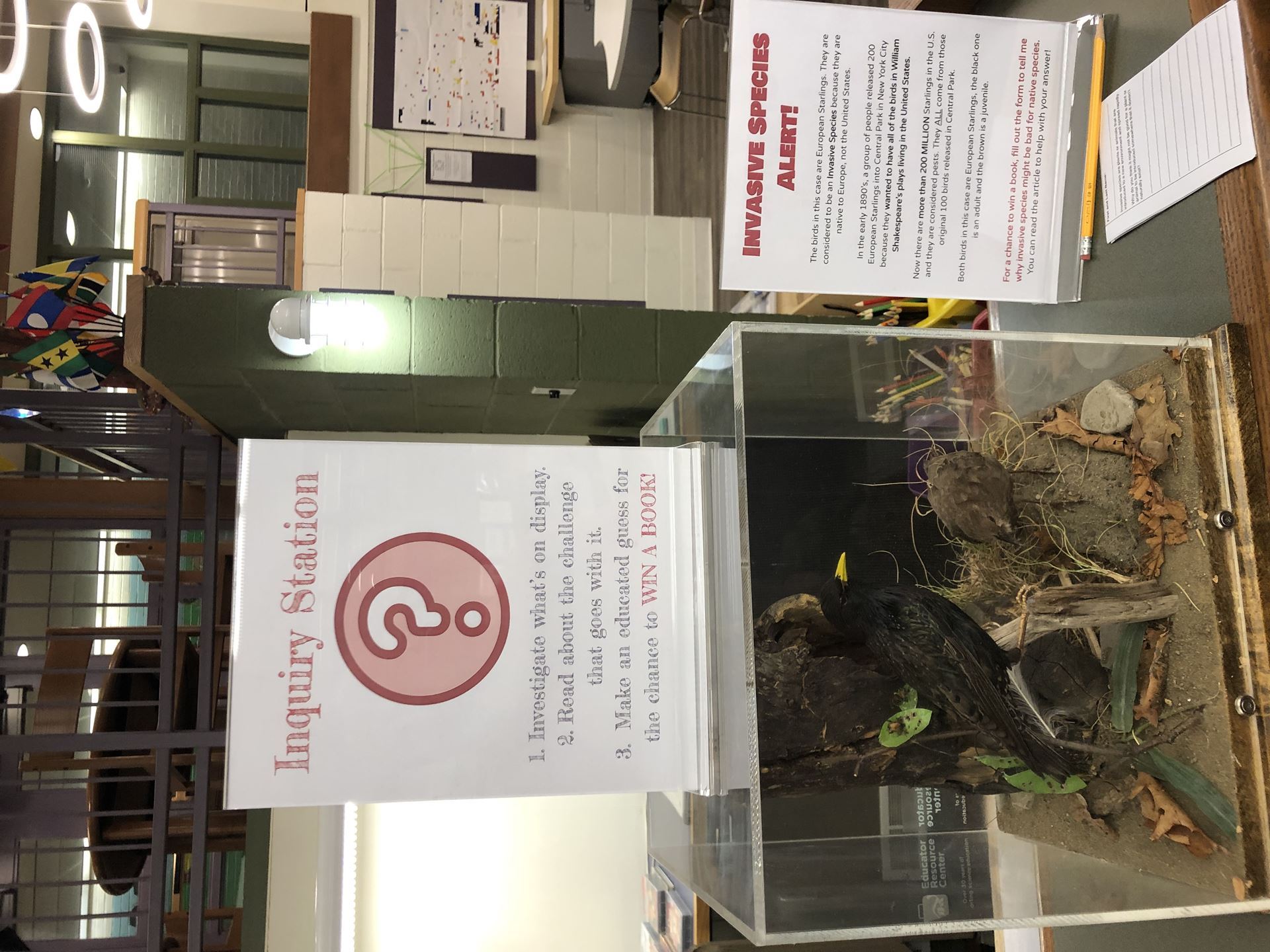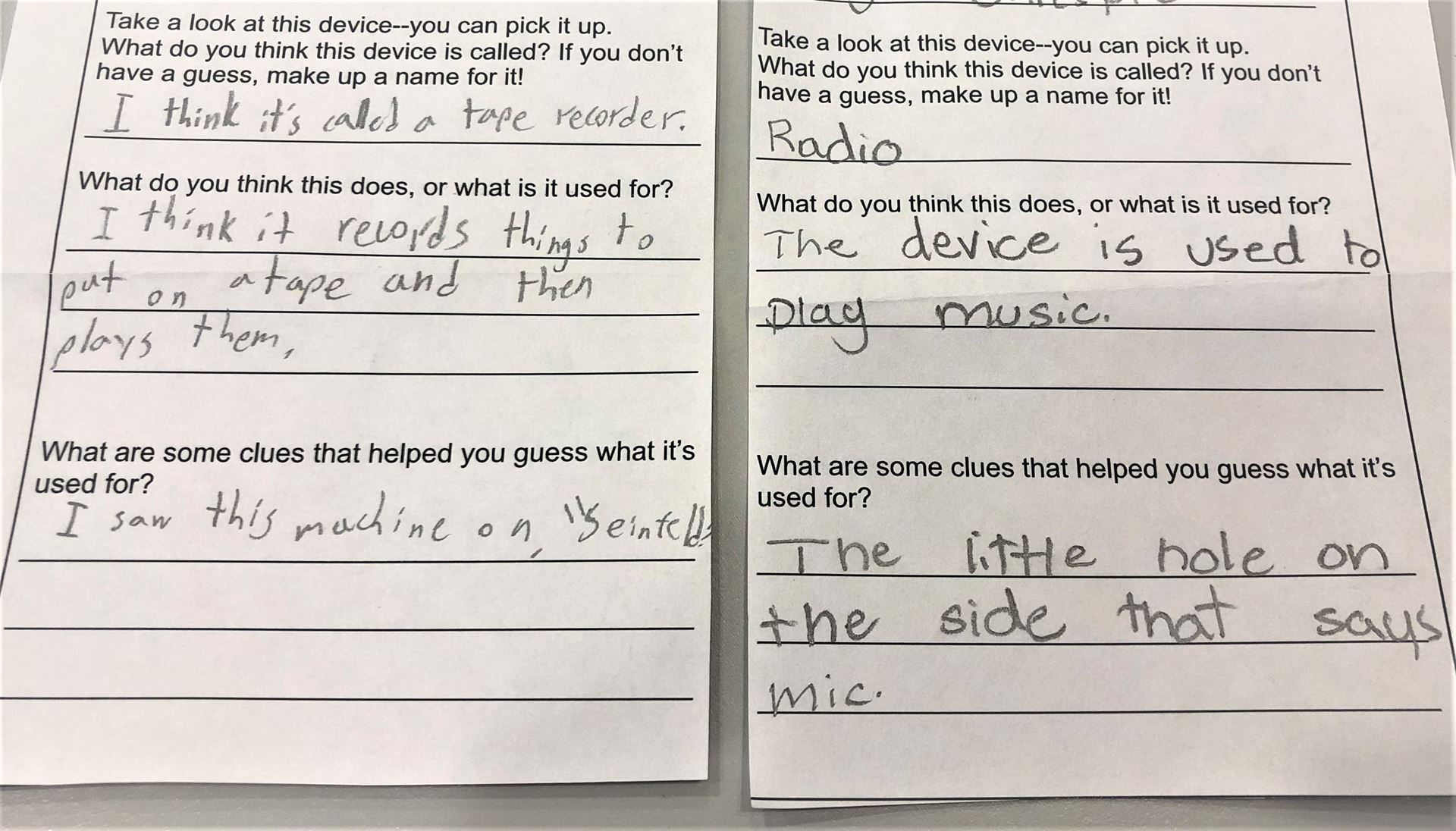AUTHOR // Rob Kaminski
Librarian, Woodbury Elementary School
Shaker Heights City Schools
Shaker Heights, Ohio
WHAT IS AN INQUIRY STATION?

An Inquiry Station in my library is a place where students can investigate an item on display and respond to a quick challenge about it. The item or topic on display can be anything that your students would find engaging and about which they can make educated guesses.
I chose to call it an Inquiry Station because Woodbury Elementary is an International Baccalaureate School and “inquiry” is a foundational aspect of the IB learning cycle. However, you could call it a “Discovery Spot” or whatever catchy name fits your school community.
Here is an example of an Inquiry Station with a display of different bird skulls and a handout showing different types of food sources for birds. The challenge called for students to match which food source they thought would be consumed by which bird.

Why Have An Inquiry Station?
I want the library to be an inviting space for everyone, which means hosting activities that go beyond reading. An Inquiry Station gives students another reason to enjoy visiting the library and to have something fun (and subtly educational) to do when they are there.
It also could reinforce learning units, skills, or themes in your school by creating Inquiry Station activities that align with learning initiatives in your building.
How Do I Create an Inquiry Station?
My best piece of advice is to use what you already have access to, you don’t have to buy anything to set up an inquiry station. Imagination is your best resource, there is no need to spend much time or energy to create one that students will love.
The components are simple:
-
Signage to draw attention to the Inquiry Station
-
The object or activity to display
-
A posted challenge about the display
-
A way for students to respond to the challenge
I am fortunate to have access to dioramas from a lending library at the Cleveland Museum of Natural History. These displays are visually engaging and easily allow for inquiry. The dioramas I’ve used have included animal skeletons, fossils, animals that use camouflage, etc. When I use these for Inquiry Stations, both students and staff are drawn to them right away. These have allowed for challenges such as:
-
What animals use camouflage and what for?
-
What animal does this skeleton belong to?
-
What are the impacts of invasive species on an ecosystem?
You may find that you are able to borrow interesting items and artifacts from area museums, historical societies or science centers.
You also can find Inquiry Station items almost everywhere. One day when I was delivering an old overhead projector to a teacher, a student in the hallway asked me if it was a 3D printer. I immediately realized that old technology would make great inquiry subjects.
I currently have a Walkman on display, but just imagine the guesses you could receive for some of that old equipment gathering dust in the back rooms!


Obviously the subjects of your Inquiry Stations will vary with age, the examples I’m sharing are for the upper elementary students that I serve. Here are some more ideas to show that you really could use anything for an inquiry station:
-
Unique tools or kitchen gadgets: Students make up a name and guess what the object is used for
-
A computer with a Nature Cam playing: Students could provide notes or guesses about the animal’s habitat, behavior, etc
-
A piece of origami in progress: Students have to guess what the final piece will be
-
Display only a small portion of a picture of a common object: Students have to guess what the object is
-
A photo of a historical event: Students could guess the time period, place, or actions related to the picture
-
Displaying an image of a work of art: Students could guess on a variety of aspects of the art: what the theme is, what materials it’s composed of, what time period it was created
Sometimes I like to pick a display where students can use books from the library to inform their guesses. If your students have devices, you could also guide them to your databases or other reliable websites to reinforce research strategies.
I usually have students respond on paper, because my library schedule requires that they interact with the Inquiry Stations in between other tasks. However, if you were using it as a class activity, you could use QR codes, Google Forms, etc., for students to respond to the challenge.

When Do Students Visit the Inquiry Station?
My library works on a flexible schedule, so students can visit the Inquiry Station anytime they have permission to be in the library. If they are here with their class, they can interact with it when there is free time before the period ends.
I usually put my station where students can complete it while they are waiting in line to check out books. You may want to do the opposite and place it somewhere else in the library to relieve congestion.
I know many elementary librarians on fixed schedules use stations that students rotate through during class, Inquiry Stations are a perfect fit for that.
Depending on your school community, you of course may need to establish rules for when students can complete an Inquiry Station challenge (after checking out, after completing work, etc.).
You know your students best and that’s what should drive what your inquiry stations are like and how they function as a part of your library.
What Do Students Get for Using the Inquiry Station?
It is up to you whether students simply experience the Inquiry Station or if you provide an award. Our District sometimes receives gift books from publishers, so I use these as rewards when available.
Most times I gather all the responses that showed any true effort (whether the answer is correct or not) and randomly pick a few winners from those responses.
Other ideas for Inquiry Station rewards could include: special bookmarks, passes for special library access (lunch in the library, Makerspace), names read on announcements, pictures of winners posted in the library, etc.
Just like with Inquiry Station ideas, if you wish to provide an award, I recommend imagination over spending money.
I also email teachers and administrators when students win so they are further encouraged and this also helps to make teachers and administrators aware that these activities are going on in the library.
If you think an Inquiry Station might be a good fit in your library, have fun with it and start small, it will evolve over time.
If you have any questions, you can reach me at Kaminski_R@Shaker.org
---
Rob Kaminski
Librarian, Woodbury Elementary School
Shaker Heights City Schools
Shaker Heights, Ohio
.jpg)